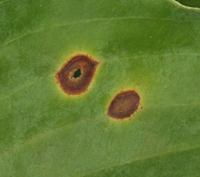|
 |
|
 |
|
 |
|
 |
 |
 Two species of bacteria,
Pseudomonas spp. & Xanthomonas spp. cause
what is called bacterial leaf spot disease on a number
of plants. Two species of bacteria,
Pseudomonas spp. & Xanthomonas spp. cause
what is called bacterial leaf spot disease on a number
of plants.
The most commonly
affected ornamental plants include:
Annuals
Black-Eyed Susan (Rudbeckia
hirta)
Flowering Tobacco (Nicotiana alata)
Geranium (Pelargonium
x hortorum)
Zinnia (Zinnia elegans /
Zinnia marylandica)
Herbaceous Perennials
Black Eyed Susan (Rudbeckia fulgida)
Coral Bells (Heuchera sanguinea)
Cranesbill, Hardy Geranium (Geranium sp. )
False Spirea (Astilbe x
arendsii)
Lenten Rose (Helleborus orientalis)
Purple Coneflower (Echinacea purpurea)
Rose Mallow (Hibiscus mosheutos)
|
 |
|
 |
 |
Spots caused by
Pseudomonas are
reddish brown and may cause the leaf to distort.
Xanthomonas infections cause small brown
angular to circular spots with yellow halos.
Occasionally, these bacteria will also cause dead
spots on the foliage and/ or fruit. Sometimes
cankers will appear on the stems of plants too.
|
 |
 |
 |
The most common
approach to bacterial leaf spot problems is the use
of sanitation. The bacteria are generally weak and
must over-winter in the old, infected foliage. So,
if you have this problem, clean up the dead foliage
and dispose of it away from the garden...and the
compost pile.
If spots have
developed on plants, avoid overhead watering since
the splashing water can often move bacteria to
nearby plants.
|
 |
 |
 |
As with other bacterial
diseases of plants, there are not good antibiotics that
are effective.
Fungicides are NOT appropriate for use on
bacterial leaf spot. See prevention above.
|
|
 |
|
Note: We
have provided some general information and
observations on this topic aimed at the home
gardener. Before you take
any serious action in your landscape, check
with your state's land grant university's
Cooperative
Extension
Service for the most current,
appropriate, localized recommendations. |
|
 |



